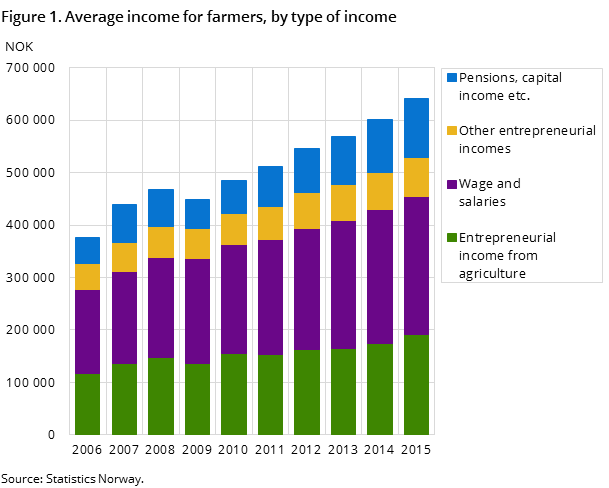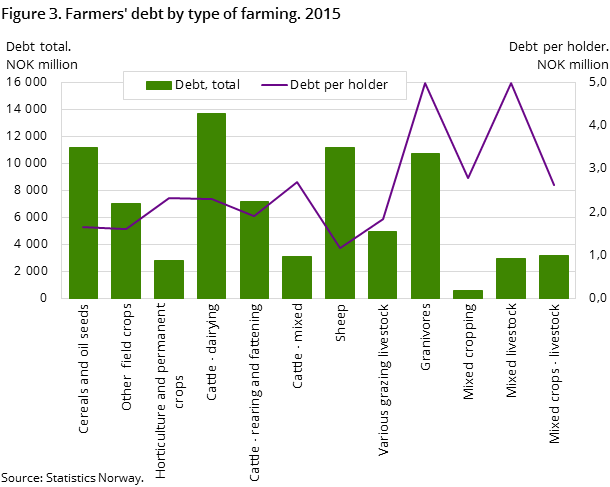Content
Published:
This is an archived release.
Agricultural incomes up 10 per cent
On average, entrepreneurial income from agriculture for farmers amounted to NOK 192 000 in 2015. This represents an increase of NOK 18 000, or 10 per cent, from the previous year. The gross income averaged NOK 642 000. Entrepreneurial income from agriculture amounted to 30 per cent of the gross income in 2015.
| 2015 | Change in per cent | ||
|---|---|---|---|
| 2014 - 2015 | 2010 - 2015 | ||
| Personal holders (number) | 39 600 | -2.4 | -9.2 |
| Average income for holders (NOK) | 642 300 | 6.7 | 32.5 |
| Wages and salaries | 263 700 | 3.2 | 27.1 |
| Entrepreneurial income from agriculture | 191 600 | 10.3 | 23.8 |
| Other entrepreneurial income | 73 300 | 2.4 | 23.6 |
| Pensions | 52 400 | 8.9 | 78.8 |
| Capital income etc. | 61 300 | 15.2 | 81.4 |
| Average debt for holders (NOK) | 1 988 000 | 5.4 | .. |



Agricultural holdings vary considerably in size, from hobby-like production to holdings with a turnover of more than NOK 1 million. This is the main reason for the considerable variation in entrepreneurial income from agriculture and debt. In 2015, farmers’ gross income averaged NOK 642 000. The gross income was made up of NOK 316 000 from wages and pensions, NOK 265 000 from total entrepreneurial income and NOK 61 000 from capital income. Average entrepreneurial income from agriculture for all 39 600 farmers was NOK 192 000. For all 27 800 farmers with a positive entrepreneurial income from agriculture, this income amounted to an average of NOK 273 000.
Different income development by type of farming
Agricultural holdings are classified by type of farming. For farmers with specialist pig/poultry, entrepreneurial income from agriculture averaged NOK 470 000 in 2015. Farmers with mixed cattle and mixed livestock also had agricultural income in excess of NOK 400 000. Agricultural income for sheep-farmers averaged NOK 91 000. Farmers with specialist pig/poultry increased their agricultural income by NOK 60 000 from the previous year. The corresponding figures for farmers with cereals and with sheep were NOK 12 000 and NOK 1 000.
For farmers with the farm type mixed cattle, three out of four had agriculture as their main source of income. Only 8 per cent of the farmers with cereals and 14 per cent of the sheep-farmers had agriculture as their main source of income.
Most debt for farmers with pigs and poultry
Farmers had a total debt of NOK 78.7 billion in 2015, corresponding to an average of NOK 2.0 million per farmer. The debt ranged from NOK 1.2 million for farmers with specialist sheep up to NOK 5.0 million on average for farmers with specialist pig/poultry and with mixed livestock. About 19 per cent of the farmers had less than NOK 100 000 in debt, while 14 per cent had more than NOK 4 million in debt. Total interest paid in 2015 amounted to NOK 2.7 billion, with an average of NOK 68 000 per farmer.
What the statistical basis includesOpen and readClose
The statistics are based on tax return data and comprise the population of agricultural holdings operated by a natural person. Of a total of 42 018 holdings in 2015, 39 600 holdings are included in these statistics.
Debt and interestOpen and readClose
Deductions, inter alia interest on debt, are not deducted from the income. The statistics are based on data sources where total debt could not be broken down into entrepreneurial debt and private debt.
Contact
-
Per Amund Aarstad
E-mail: per.amund.aarstad@ssb.no
tel.: (+47) 40 81 13 79
-
Berit Bjørlo
E-mail: berit.bjorlo@ssb.no
tel.: (+47) 40 81 13 76
